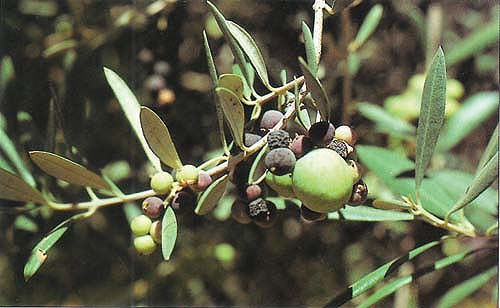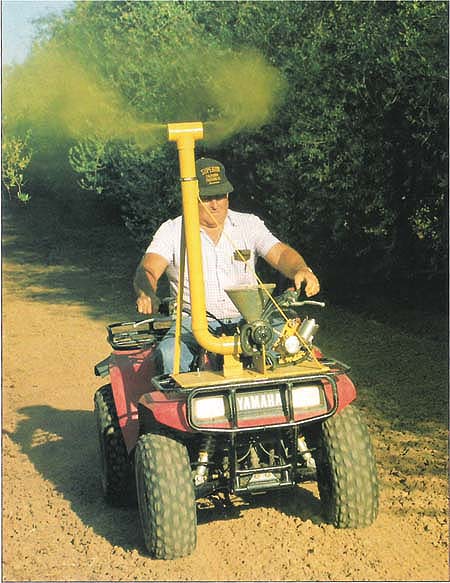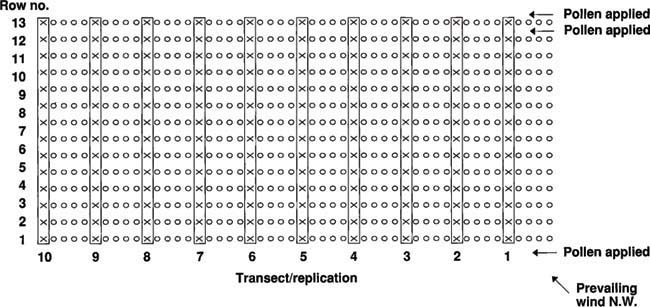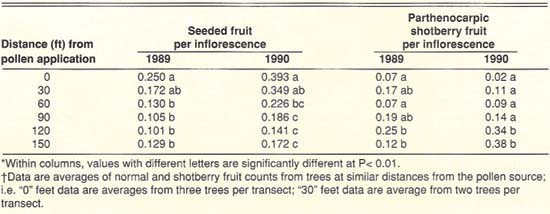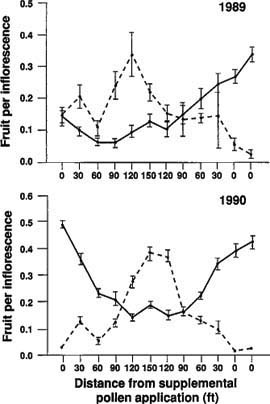All Issues
Normal fruit set is up; shotberries are down: Topical application of ‘Sevillano’ pollen to ‘Manzanillo’ olive proves effective
Publication Information
California Agriculture 46(3):21-23.
Published May 01, 1992
PDF | Citation | Permissions
Abstract
Topically applied 'Sevillano' olive pollen increased the percentage of normal fruit set and reduced incidence of worthless shotberry 'Manzanillo' olives. Applications were effective up to 90 feet from the pollen source.
Full text
The ‘Manzanillo’ olive (Olea europaea) is the preferred cultivar in California for processing into “ripe” olives because it is uniform in size, firm and easy to process. It is widely planted. When planted singly in solid blocks, especially in locations isolated from other olive cultivars, it produces poor crops of normal, seeded fruit and an abundance of the parthenocarpic and commercially useless fruit called shotberries.
Pollen source can influence production of normal and shotberry ‘Manzanillo’ olives. Although ‘Manzanillo’ is self-compatible, seeded fruit increased and shotberries declined when pollens of other olive cultivars fertilized its flowers. In those experiments, pollens from the olive cultivars ‘Barouni’ and ‘Sevillano’ best improved production of seeded ‘Manzanillo’ fruit and reduced incidence of shotberries. Pollens from the cultivars ‘Mission’ and ‘Ascolano’ were less effective, whereas self-pollinated ‘Manzanillo’ flowers produced the most shotberries and the lowest number of seeded fruit. Those experiments suggest that some degree of self-incompatibility may occur within ‘Manzanillo’.
When increased production is needed, cross-pollination of ‘Manzanillo’ is recommended. Ideally, ‘Manzanillo’ plantings should include approximately 10% of another cultivar, preferably ‘Sevillano’ or ‘Barouni’, for optimal production. Pollinizer trees should be planted in rows across the direction of prevailing wind to disseminate the pollen and promote cross-pollination.
Growers usually do not want to commit 10% of their acreage to pollinizers for ‘Manzanillo.’ The market for other olive cultivars, especially ‘Barouni’ and ‘Sevillano,’ is limited and returns can be substantially lower. Moreover, additional cultivars in a grove complicate management that is, harvest timing varies and pest control problems differ. Providing for cross-pollination for ‘Manzanillo’ without commitment of land would be of value to industry. Here, we report results of an experiment to determine the feasibility for topical application (dusting) of supplemental ‘Sevillano’ pollen to promote production of normal fruit and reduce incidence of shotberries in ‘Manzanillo’.
Methods
The experiment was conducted during 1989 and 1990 in a mature, 232-acre block of ‘Manzanillo’ olives managed by the S & J Farming Company, Madera, California. We selected a block with a chronic history of poor annual production, including an abundance of shotberries. The pollinator of this block is ‘Ascolano,’ unlike more productive blocks on the ranch where every tenth row (10% of the acreage) is planted to ‘Sevillano’ for pollination. Due to poor performance of the ‘Manzanillos’ in this block, the ‘Ascolanos’ were regrafted to ‘Sevillano’ in 1989. No ‘Sevillano’ bloom developed on the new grafts that year; the second year, any flowers were removed before bloom. Thus, within the plot, only ‘Manzanillo’ pollen was present during the test years.
Thirteen rows of ‘Manzanillo’ trees, planted 30 feet apart east-west across the direction of the prevailing wind, were selected for the experiment. Four times during the bloom, 30 grams of undiluted ‘Sevillano’ pollen per acre were supplementally applied to the northern-and two southernmost rows of the experimental plot. Rows 2 through 10 did not receive direct supplemental pollen applications. Applications were made at the beginning of bloom, two times during midbloom, and a final application at approximately 50% petal fall. A total of 120 grams of ‘Sevillano’ pollen was applied per treated acre each year of the experiment. The supplemental pollen was dusted onto the trees by metering it through a modified leaf blower mounted on an all terrain car (ATC) traveling approximately 15 miles per hour down the designated rows (see photos, p.).
We measured normal seeded and shotberry fruit production on individual trees in ten transects (replications) at five-tree intervals traversing the 13 experimental rows. The transects were oriented from north to south across the east-west rows (fig. 1). Each year before bloom, but when inflorescences could be distinguished, we selected ten 1-year-old flowering shoots on each tree (five on the north and five on the south side) in each transect for observation. Selected shoots were approximately 18 to 24 inches long and contained between 10 and 20 inflorescences. The inflorescences were counted back from the terminal, a tag placed at that point and the number of inflorescences recorded on the tag. The same transects and observation trees were used each year of the experiment.
Two months following bloom, seeded and shotberry fruits were determined on each tagged shoot. Seeded and shotberry fruit per inflorescence were calculated for each observation tree in each row. The resulting data were analyzed by analysis of variance (ANOVA) and Scheffe’s post hoc test to determine the effect of distance from the topically applied pollen source on seeded and shotberry fruit production.
The ‘Sevillano’ pollen used in the experiment was obtained from commercial sources each year. Its viability was determined before treatment using the fluorescein diacetate (FDA) test and found to be 46.9% for 1989 and 54.5% for 1990. Such viability is consistent with that reported for olive pollen by other researchers.
Fig. 2. Number of normal and shotberry fruit per inflorescence of ‘Manzanillo’ olive across north-south transect after four topical applications of ‘Sevillano’ pollen to each end of the transects in 1989 and 1990. (Solid lines indicate seeded fruit; dotted lines indicate shotberry fruit. Each data point represents mean fruit per inflorescence for 10 inflorescences from each of 10 tree replications per row. Bars represent two times the standard error of the mean.)
Results
Normal, seeded ‘Manzanillo’ fruit set decreased and incidence of shotberry fruits increased with distance from topical applications of supplemental ‘Sevillano’ pollen (fig. 2).
1989 results. Normal fruit set ranged from a high value of 0.34 per flower in a row where pollen was applied to a low of 0.06 fruit per inflorescence 90 feet away from the single row and 210 feet from the two rows dusted with pollen. The number of shotberries was highest 120 feet from the nearest pollen application and lowest in a row where pollen was applied (fig. 2). Highly significant reductions (P < 0.01) in seeded fruit occurred at distances greater than 60 feet, and increases in parthenocarpic shotberries occurred at distances greater than 120 feet from the topically applied supplemental ‘Sevillano’ pollen (table 1).
1990 results. Set of normal, seeded fruit was higher in 1990 than in 1989. Seeded fruit per inflorescence ranged from 0.49 in the single row where pollen was applied to a low value of 0.14 per inflorescence 120 feet and 170 feet from the two pollinated rows. Shotberry numbers were highest 150 feet from the nearest pollen application and lowest in the row where ‘Sevillano’ pollen was topically applied (fig. 2). A highly significant reduction (P< 0.01) in mean normal fruit and a highly significant increase in shotberries per inflorescence occurred at distances greater than 90 feet from the topical application of supplemental pollen (table 1).
Discussion
Cross-pollination is known to improve seeded fruit set and to reduce incidence of worthless shotberries in ‘Manzanillo’ olive. The work reported here clearly demonstrates that topical applications of pollen can be a feasible substitute for committing land to a pollinizer cultivar. In our experiments, percent fruit set of normal seeded ‘Manzanillo’ fruit was significantly improved; incidence of shotberries was significantly reduced among those fruit in close proximity to topically applied, supplemental ‘Sevillano’ pollen.
Olive is an evergreen species where a dense canopy of leaves can impede dissemination of windborne pollen. In this work, seeded fruit set was significantly reduced at distances greater than 60 to 90 feet from the pollen source, and shotberries significantly increased at distances greater than 120 feet. These data suggest supplemental pollen should be applied at intervals not exceeding 60 feet — every third middle in an orchard having a 30-foot row spacing.
We applied the 30 grams per treated acre of undiluted supplemental pollen four times during bloom. Such a treatment costs approximately $110 per treated acre. Further work is needed to better establish required rates of pollen per acre and frequency of topical application for optimal results. The effects of topical applications of supplemental pollen to other olive cultivars need to be studied.



